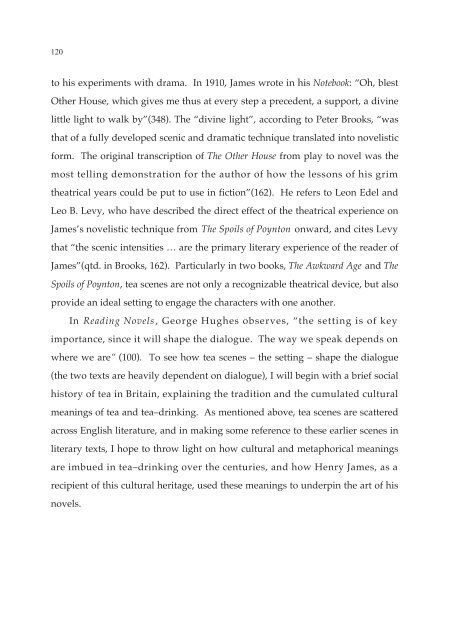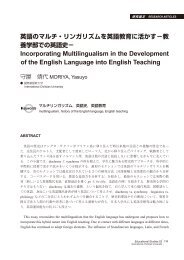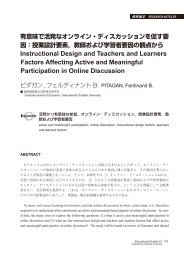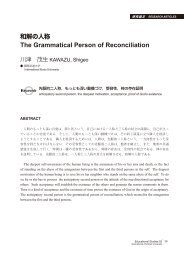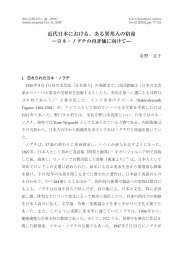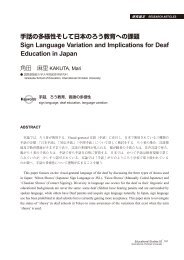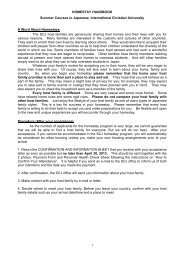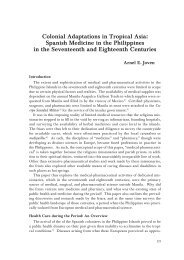Tea and Henry James's 'Scenic Method' in The Awkward ... - subsite
Tea and Henry James's 'Scenic Method' in The Awkward ... - subsite
Tea and Henry James's 'Scenic Method' in The Awkward ... - subsite
Create successful ePaper yourself
Turn your PDF publications into a flip-book with our unique Google optimized e-Paper software.
120<br />
to his experiments with drama. In 1910, James wrote <strong>in</strong> his Notebook: “Oh, blest<br />
Other House, which gives me thus at every step a precedent, a support, a div<strong>in</strong>e<br />
little light to walk by”(348). <strong>The</strong> “div<strong>in</strong>e light”, accord<strong>in</strong>g to Peter Brooks, “was<br />
that of a fully developed scenic <strong>and</strong> dramatic technique translated <strong>in</strong>to novelistic<br />
form. <strong>The</strong> orig<strong>in</strong>al transcription of <strong>The</strong> Other House from play to novel was the<br />
most tell<strong>in</strong>g demonstration for the author of how the lessons of his grim<br />
theatrical years could be put to use <strong>in</strong> fiction”(162). He refers to Leon Edel <strong>and</strong><br />
Leo B. Levy, who have described the direct effect of the theatrical experience on<br />
James’s novelistic technique from <strong>The</strong> Spoils of Poynton onward, <strong>and</strong> cites Levy<br />
that “the scenic <strong>in</strong>tensities … are the primary literary experience of the reader of<br />
James”(qtd. <strong>in</strong> Brooks, 162). Particularly <strong>in</strong> two books, <strong>The</strong> <strong>Awkward</strong> Age <strong>and</strong> <strong>The</strong><br />
Spoils of Poynton, tea scenes are not only a recognizable theatrical device, but also<br />
provide an ideal sett<strong>in</strong>g to engage the characters with one another.<br />
In Read<strong>in</strong>g Novels, George Hughes observes, “the sett<strong>in</strong>g is of key<br />
importance, s<strong>in</strong>ce it will shape the dialogue. <strong>The</strong> way we speak depends on<br />
where we are” (100). To see how tea scenes – the sett<strong>in</strong>g – shape the dialogue<br />
(the two texts are heavily dependent on dialogue), I will beg<strong>in</strong> with a brief social<br />
history of tea <strong>in</strong> Brita<strong>in</strong>, expla<strong>in</strong><strong>in</strong>g the tradition <strong>and</strong> the cumulated cultural<br />
mean<strong>in</strong>gs of tea <strong>and</strong> tea–dr<strong>in</strong>k<strong>in</strong>g. As mentioned above, tea scenes are scattered<br />
across English literature, <strong>and</strong> <strong>in</strong> mak<strong>in</strong>g some reference to these earlier scenes <strong>in</strong><br />
literary texts, I hope to throw light on how cultural <strong>and</strong> metaphorical mean<strong>in</strong>gs<br />
are imbued <strong>in</strong> tea–dr<strong>in</strong>k<strong>in</strong>g over the centuries, <strong>and</strong> how <strong>Henry</strong> James, as a<br />
recipient of this cultural heritage, used these mean<strong>in</strong>gs to underp<strong>in</strong> the art of his<br />
novels.


